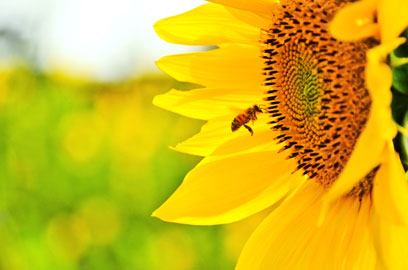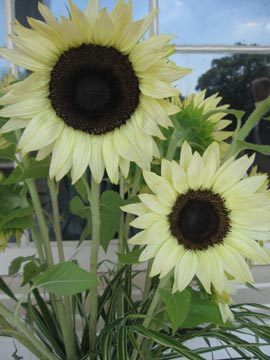Sunflowers have power. They give a drab garden instant zing, but they also provide food, shade, structure, and energy. Most of all, they are great for supporting pollinators and wildlife. With all those attributes, it is flat out amazing how easy they are to grow from seed in your own home garden.
 Bee flying near Sunflower
Bee flying near Sunflower
© Thinkstock
You need a sunny spot. (They don’t call them sunflowers for nothing!) They are not picky about soils, but make sure it is well-draining as they do not like wet feet. Seed them about 6 inches apart either in clumps of 3 or in rows. You can start them indoors and plant them out after the last frost, though they are just as easy to direct-sow.
Keep your seedlings well-watered. They grow fast. Once established, they do not need much watering unless it has not rained in your area for a few weeks.
 Sunflower fields as far as the eye can see at McKee-Beshers Wildlife Management Area in Montgomery County. MD, are a popular photography spot."
Sunflower fields as far as the eye can see at McKee-Beshers Wildlife Management Area in Montgomery County. MD, are a popular photography spot."
© Kathy Jentz
Most sunflowers do not need staking. If you plant them where they get constant wind, or lean out from shade into the sun, then tie them with soft cloth strips to a sturdy rod of rebar or metal stake.
Sunflowers make great trellises for edible climbing plants like beans or ornamental annual vines. You can also use tall sunflowers to create an almost instant fence and shade around a portion of your garden. Small children enjoy planting and playing in a sunflower house made up of tall varieties planted in a tight circle. Be sure to leave 2-3 feet of room for the door opening!
 Sunflower 'Coconut Ice' is a recent introduction from Burpee. The petals start out a light cream color and age to pure white
Sunflower 'Coconut Ice' is a recent introduction from Burpee. The petals start out a light cream color and age to pure white
© Kathy Jentz
There are an amazing variety of sunflowers available in seed catalogs. You can choose from knee-high to gargantuan. Some produce huge heads full of nutritious seeds, while others are “teddy bear” style covered in fuzzy petals and are practically sterile. Then there are the color choices – classic yellow is always in fashion, but don’t stop there. Check out the chocolate hues, deep reds, and buttery creams.
Sunflowers make a great cut flower. One caution though, you want to put them in a bottom-heavy vase, so that when they turn to face the sun, they don’t topple over, taking the vase with them.
Leave your sunflower heads on the plant through the end of the season to allow the wildlife to enjoy the seeds and the extra ones, spilled on the ground, will sometimes grow for you next year. You can also cut the flowerheads and hang them to dry and harvest them yourself for seeds to share with other gardeners.
Once you are ready to take down your plants, you will find that the stalks are quite strong and fibrous. Chop them up before adding them to your compost pile.
By Kathy Jentz